Real-world Applications Of AI
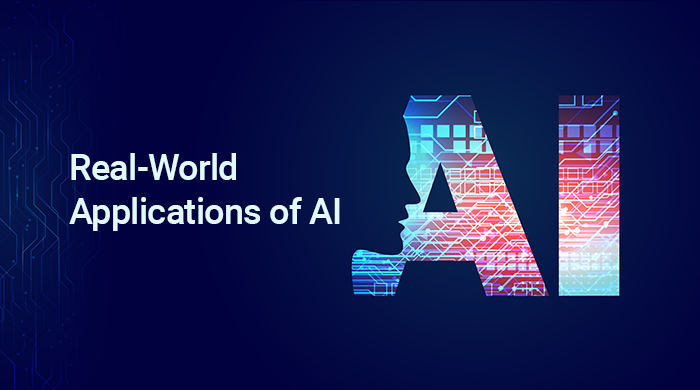
When we think about artificial intelligence or AI, we suddenly start picturing human-like robots taking over the earth and what not! These thoughts are just the results of movies and stories influencing our thought process painting such an unreal version of AI in our heads. Recently, there was even a debate between Elon Musk and Jack Ma about AI, its effects and future possibilities, which was actually fun to watch as even they were having a heated debate about robots taking over the world.
All these stories, discussions and debates will only lead us to one conclusion, artificial intelligence is important and it is the next big thing.
Let’s stop thinking about machines taking over the world for a bit. We’re not saying that it isn’t a possibility. It’s just not something that’s going to happen in the foreseeable future taking into account the present state of AI.
Many people and companies have built many advanced versions of AI already, but it is still not anywhere near human capabilities.
All this doesn’t mean that artificial intelligence in the present state is useless. It is still one of the top disruptions that are driving the technology world at present. The real-world applications of AI are immense and if you look around there is widespread adoption of AI and it’s practiced in all technology platforms and companies.
Huge investments are flowing into disruptive companies that have successfully implemented real-world AI applications. In this article, we will be discussing some real-world applications of artificial intelligence.
AI in Healthcare
Healthcare has evolved so much in the past 100 years and this was the result of the industrial revolution and economic growth which could invest a lot of time and money into this industry. Modern tools and machinery have become an integral part of healthcare, from diagnosis to cure and ailments.
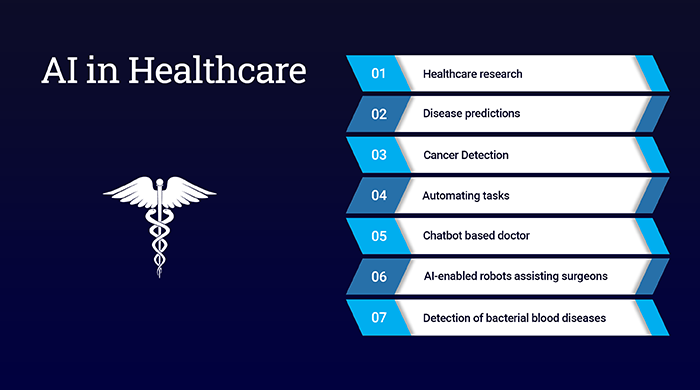
In present-day medicine, AI has also become a crucial aspect of medical processes. There are tons of use cases in which engineers are building solutions in AI. Some examples involve cancer detection, disease predictions, etc. Most of the presently available disease diagnosis techniques involve a lot of human interaction which could also lead to error in judgment.
Due to the wrong diagnosis of the diseases, many deaths were reported. By the use of AI, by automating everything, a lot of such occurrences can be minimized. By analyzing large amounts of available data, machines can come to conclusions at a much efficient and faster rate than their human counterparts. Other than the above-mentioned examples, some notable companies/startups are doing some remarkable job in making predictions from a lot of unstructured healthcare data, detection of bacterial blood diseases by scanning blood through AI-driven microscopes, healthcare research, automate hospital operations by automating tasks, chatbot based doctor consultations, etc.
There is also a lot of advancements in AI-enabled robots assisting surgeons about more will be discussed in the subsequent sections. Even though a lot of things have happened as far as AI in healthcare is concerned, there is a long way to go.
At this point, AI won’t completely replace humans in health care as healthcare also depends on human emotionally driven tasks like care, empathy, etc. In the future, humans will definitely have to learn to work alongside machines and AI.
AI in Defense
The global military budgets, combining the amount of money spent by each country for defense, will be roughly 2 trillion dollars. A big portion of such massive spending will also go into research and the world’s most advanced military have also started spending a lot in AI in defense.
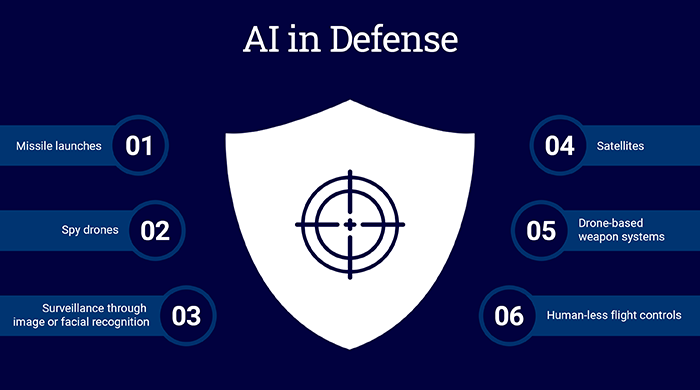
This could be a reason to worry for some as the right technology in the wrong hands could lead to the end of the world. Most of the present-day prevalent AI applications in defense are in the field of human-less flight controls, surveillance through image or facial recognition, missile launches, drone-based weapon systems, spy drones, satellites, etc.
Using vast amounts of data collected from defense satellites and cameras across the globe, the defense systems could locate wrongdoers and increase security immensely. The US is the leading spender in AI defense budgets followed by China and the UK and all these countries have made significant advancements in this area.
By combining the AI capabilities of the software, hardware (robotics), weapon systems and large amounts of data, the military could be made autonomous. Even though there are a lot of perks associated with these, the big question remains!
AI in Retail
Retail is one of the biggest industries in the world at a market size of 31 Billion with some behemoth companies ruling the markets and still, local small business owners are also highly successful. With its huge potential and growth, companies have also started investing in retail technologies and AI to improve sales.
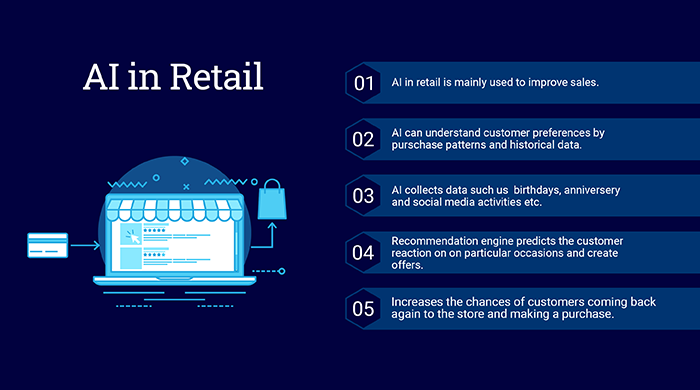
Most of the present-day applications of AI are revolved around understanding the customer preferences by working on top of the purchase patterns of a customer from the historical data. Big companies run large loyalty and customer reward programs to make this happen.
Using the reward programs, by making their customers join, the companies are not just distributing points, but collecting valuable data like purchase date, purchase value, products purchased, birthdays, anniversaries, social media activities, etc.
By building recommendation engines on top of such data, companies can make predictions on how the customers are going to react on particular occasions and then create offers around such predictions, thereby increasing the chances of customers coming back again to the store and making a purchase.
Data collection in traditional retail happens at the Point of Sale’s (POS) terminals mostly whereas the online retail companies use a variety of techniques to collect such data. Other than running predictive algorithms on top of the data, the data is used for a variety of things like sending out email campaigns, run online ads, etc.
Other than AI in marketing, it is also used to improve customer experiences. More research and innovation are happening in the area and we can definitely expect more disruptions in the future.
AI in Marketing and Advertising
The applications of AI in marketing are very similar to what was explained in retail. Marketing collects a lot of data from the customers and later machine learning algorithms work on top of it to bring out predictions based on which marketing teams can make marketing decisions that can be used to improve the sales.
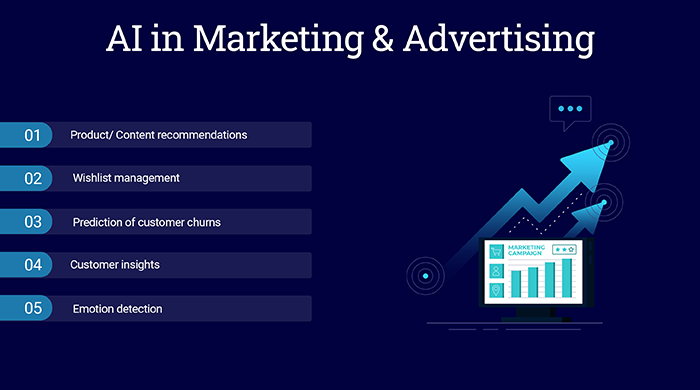
This is usually done to understand the next move of the customer and to make the journey of the customer easier. Other than this, a lot of marketing automation opportunities have also opened up with the introduction of AI in marketing.
Google and Facebook are companies that successfully do this in ads. These companies dominate AI in marketing. The data of billions of data sets that they already have is used to deliver better-targeted ads. Using their ad delivery platforms, digital platforms can reach out to any individual in any part of the world.
Some examples of the usage of artificial intelligence in marketing are:
- Product/ Content recommendations: These are mostly done through ad platforms. Based on the customer’s browsing history and purchase history, products and contents are predicted and showed on the customer PC or phone screens.
- Wish list management: While browsing through e-commerce platforms, a lot of up-selling and cross-selling recommendations happen based on what was ordered and what was added in the wishlist.
- Prediction of customer churns: This is very useful for SaaS companies to understand whether the customer is not engaging with the product as they were used to. This increases the chances of customers eventually leaving or stop using the product.
- Customer insights: Machine learning algorithms can look at millions of data sets available and then convert them into powerful visually appealing insights that can be used to improve marketing performances.
- Emotion detection: In physical retail locations, the data from the surveillance cameras can be used to understand and predict the mood of the customer when they visit each product stand and such data can be used to push better and appealing offers to the customers in real-time.
AI in Customer Support
Customer support is another industry that has been disrupted by automation and AI. Companies are saving a lot of money by making automated AI-powered bots take care of many tasks that are traditionally done by humans.
Some of these tasks include talking to a potential customer, providing support to existing customers, troubleshooting, etc. The best about AI is customer support is that the customers get a better service as the bots are available 24*7 around the calendar and hence the customers don’t have to wait to get something done.
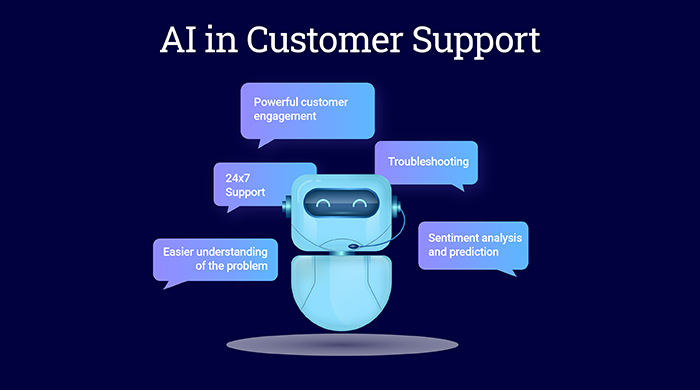
Some other advantages of this approach are powerful customer engagement and easier understanding of the problem and scope for improvement as everything is recorded and the data from customer chats are used for improving the whole process.
Using sentiment analysis and prediction, the bots will try and understand in what mood the customer is and if the customer is not happy, the whole process can be escalated to a real person, who can then take care of the customer and solve his issue for him.
Robotics And Artificial Intelligence
This is a very interesting industry to watch out for it has generated a lot of interest in the common man by letting us see and read all the comics and sci-fi movies that talk about this.
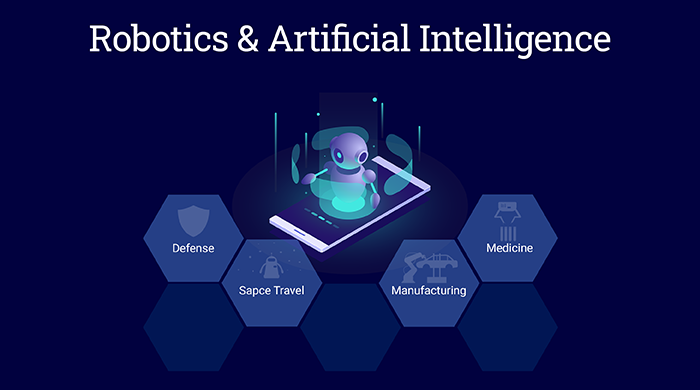
So are we talking about the next Ultron here, the artificially intelligent supervillain? One thing that we can say for sure is that the present state of AI is not advanced enough to build something like that.
The most similar thing that we may have seen recently might be the super cute animal-like robots made by Boston Dynamics jumping around cliffs, doing summersaults, and carrying weights balancing on their legs and the humanoid robot Sophia who can talk very similar to an actual human and can mimic human facial expressions.
In the real-world, robotics find applications in several industries like manufacturing, medicine, space travel, defense, and a lot more. The manufacturing industry cannot survive now without robotics.
Programmed robot arms are more efficient, precise than human arms and can work night and day. Most of the real-world robotics applications are not driven by AI and these are just plain examples of programmed automation.
AI applications in robotics are applicable when the robots start doing things on their own with the help of machine learning. So robotics coupled with smart software does the job. For example, in healthcare, if there is a tiny robot that can enter the bloodstream of a patient, diagnose the disease and maybe destroy the harmful bacteria or cancer cell, that is a huge disruption and a win for AI.
This is just an example use case. Presently there are medical robots that help in surgeries assisted by AI-based algorithms. Space travel is another area where robotics can benefit the most with AI.
Conclusion
We discussed many real-world applications and future possibilities of artificial intelligence. It is true that only a handful of companies and governments around the world has access to the resource and capital to invest in the growth of AI. Even the smaller companies that come up with AI disruptions get acquired by the giants or to the defense departments of countries.
A lot of innovation and research is happening in the fields of machine learning, natural language processing, predictive analysis, and recommendation engines. AI is considered as the ‘Industrial revolution 2.0’ and a lot of things are in store for the future. Let’s wait and find out, and if possible contribute something to the growth of Artificial Intelligence.
Get Started with our AI ServicesBlogs by Category
AppForms Artificial Intelligence Blockchain Call Centers Chatbots Cloud Computing Data Management Design Digital Marketing Digital Transformation Enterprise Applications FinTech Insights LowCode Development Microsoft Mobile Apps News Office 365 Robotic Process Automation Security SharePoint Software Development Web ApplicationArtificial Intelligence in Retail
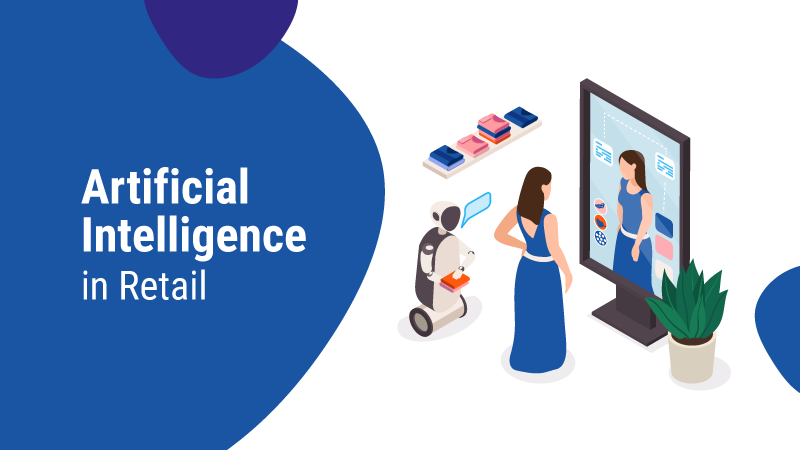
2024-05-23 14:12:28